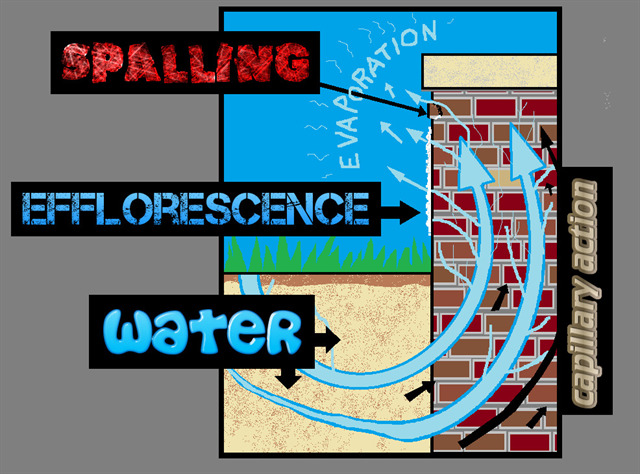This is an Earthcache – as such, there is no physical cache. Instead you will partake in a geology lesson by making observations and answering 5 questions about the efflorescence effects on porous brick, mortar, marble, and sandstone at the Manassas Industrial School & Jennie Dean Memorial. Permission for this listing has been granted by Manassas City Parks. No night caching allowed.

WHAT IS EFFLORESCENCE?
Efflorescence is a powdery or crystalline deposit of salts that is often visible on the surface of brick, concrete, or natural stone surfaces. It occurs when water leaves behind salt deposits on the surface. In French the word efflorescence means "to flower out," but this flowering leaves an unattractive crusty white layer of anhydrous copper(II) sulfate on the surface of porous stone.
HOW DOES IT FORM?
For efflorescence to occur all that is needed is water and salt. The salt could start from outside the stone from sources such as storm runoff, sea water, or winter ice melt. Salt may also already be present inside the natural stone, or inside building materials such as brick, stone, or concrete.

First salt must be dissolved in water and become a brine. When this brine makes contact with porous masonry materials or natural stone it gets drawn in and transported by a process called capillary action. The brine will eventually find a path to the stones surface, evaporate, and leave behind crystallized deposits off salt.

IS EFFLORESCENCE DESTRUCTIVE TO THE STONE?
Efflorescence is not normally damaging, but it is aesthetically undesirable.
If the salt water being transported through is too much for the stone to handle, the material will break apart or spall. Spalling is when stone, concrete or brick that is deteriorating from moisture that has penetrated it. In the winter when moisture is drawn to a concrete or brick surface, it will freeze and expand, and this will ultimately cause the stone to crack or spall.

Manassas has a humid, subtropical climate with multiple wet/dry and freeze/thaw cycles. When temperatures reach below freezing, any porous stone surfaces that have allowed water to be absorbed will be affected during these freeze thaw cycles. Upon freezing its volume expands, causing a large force which busts out of the stones outer surface.
LOGGING REQUIREMENTS:
To log this Earthcache: Read the geology lesson above. Answer all five questions posted below. Answers can be sent via e-mail or messenger contacts on my Geocaching profile within a reasonable time. Group answers are fine, but list the members of your party in your logs or wit your answers. Do not post the answers to the questions in your found logs.
QUESTION 1. What action pulls moisture up and through the stone?
QUESTION 2. How is the Efflorescence affecting the brick and mortar of the CARNEGIE BUILDING arch?
QUESTION 3. Walk over to waypoint 2 and observe brick column and especially the marble CLASS OF 1942 plaque. How is the efflorescence here effecting the brick and the marble plaque?
QUESTION 4. Walk over to waypoint 3 and observe the natural sandstone and marble GLORY OF GOD marker. Is this marble plaque experiencing the same issues as the one at way point 2?
QUESTION 5. From your observations of all three waypoints, deduce how the efflorescence came to be at these memorial markers. Is the majority of salt being introduced from the ground, the natural stone, or from the newer building materials?
OPTIONAL PHOTO: Posting a photo that readily indicates that you (and anyone else logging the find) are at the location.
 Awesnap has earned GSA's highest level:
Awesnap has earned GSA's highest level:

 Best Earthcache
Best Earthcache
REFERENCES
1. Effloresence, Website, wikipedia.org
2. What Is Efflorescence?, by Elizabeth Weintraub, The Balance, June 29, 2020, website, thebalance.com